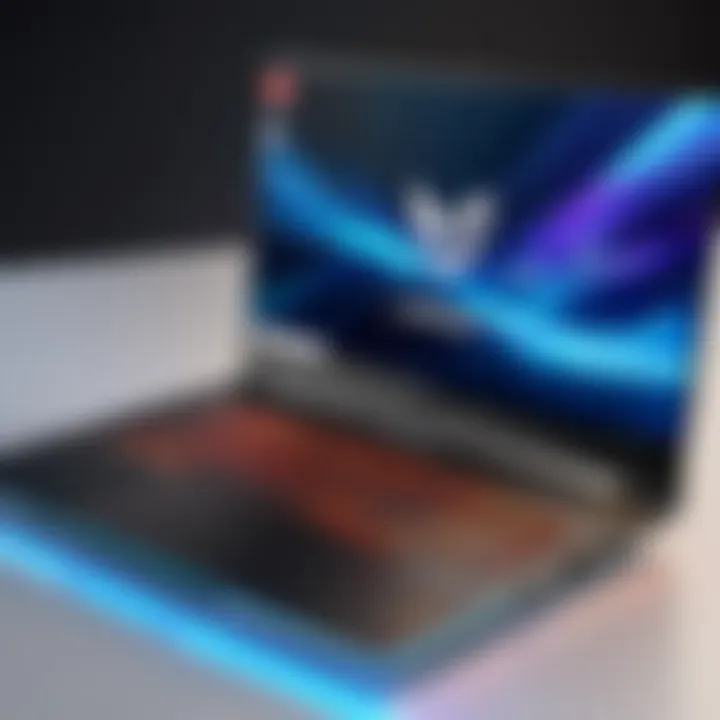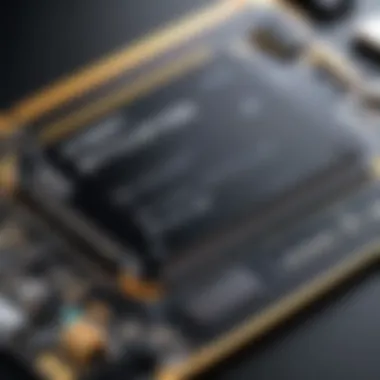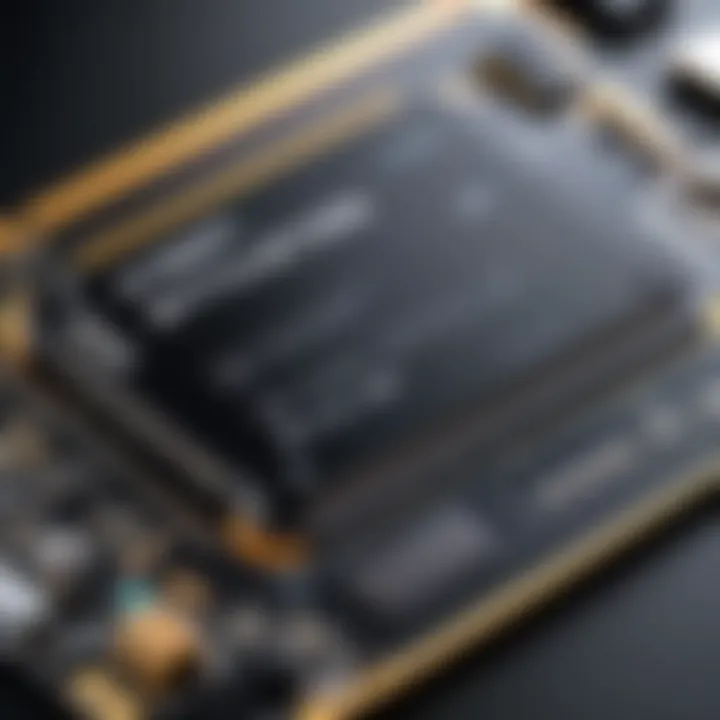Gaming Laptops vs Regular Laptops: Key Differences


Intro
The landscape of computing devices has evolved significantly over the years, with laptops becoming increasingly central to both work and play. A common point of contention among users is the difference between gaming laptops and regular laptops. This is not merely a matter of branding but involves distinct hardware specifications, design considerations, and performance capabilities tailored to specific user needs. Understanding these differences can help consumers make informed choices, based on their unique use cases, whether they are gamers, professionals, or casual users.
Product Overview
When discussing gaming laptops, it is crucial to note that these machines are built for high-performance tasks, especially video games that demand a lot of processing power and graphical capabilities. In contrast, regular laptops tend to focus on everyday tasks like browsing, word processing, and streaming.
Brand information
Several brands have positioned themselves as leaders in the gaming laptop market. Brands like Alienware, Razer, ASUS ROG, and MSI offer a range of products designed specifically for gaming. Regular laptop manufacturers, such as Dell, HP, and Lenovo, also provide options suited for everyday use.
Key specifications
Gaming laptops generally feature more powerful hardware including:
- High-performance CPUs like Intel Core i7 or AMD Ryzen 7
- Dedicated GPUs, such as NVIDIA GeForce RTX series or AMD Radeon RX series
- Enhanced cooling systems to manage heat during extensive gaming sessions
Regular laptops might come with:
- Mainstream CPUs, like Intel Core i5 or AMD Ryzen 5
- Integrated graphics, adequate for basic needs
- Simpler cooling systems as they do not face the same demands.
Pricing
The cost of gaming laptops is usually higher, reflecting their advanced features and performance capabilities. Prices typically start from roughly $1,200 and can exceed $3,000 based on specifications. Regular laptops, however, have a broader price range, often starting around $300, making them accessible to a wider audience.
Performance Comparison
When evaluating performance, benchmark tests serve as an essential tool for understanding how much power a laptop can offer. High-end gaming laptops consistently outperform regular laptops in most benchmarks. They can handle demanding graphics and complex simulations. In contrast, regular laptops handle less intensive tasks more comfortably, making them efficient for typical workflows without compromising power.
- Benchmark tests: Gaming laptops score higher in GPU benchmarks, indicating superior graphics performance.
- Speed and efficiency comparisons: Although regular laptops display adequate speeds for daily tasks, their efficiency drops significantly with multitasking or running heavy applications.
Features and Technology
Unique features of gaming laptops include customizable RGB lighting and mechanical keyboards designed for a better gaming experience. Regular laptops focus more on ergonomics and portability and often come with longer battery lives for day-to-day use.
Technological advancements
Gaming laptops may incorporate advanced cooling solutions, faster refresh rates, and higher-resolution displays. These elements enhance the overall gaming experience through smoother visuals and improved responsiveness. Regular laptops often prioritize battery longevity and user-friendliness over cutting-edge technology.
Compatibility with other devices
Gaming laptops tend to offer better connectivity options for peripherals and external displays, which are essential for immersive gameplay. This includes support for various gaming accessories, such as gaming mice, keyboards, and VR equipment. On the other hand, regular laptops focus on standard productivity peripherals, providing USB ports and HDMI connections suited for office tasks.
Pros and Cons
Strengths of the product
- Gaming laptops: High-performance hardware, great graphics, advanced cooling solutions, and immersive gaming features.
- Regular laptops: Affordability, lightweight design, longer battery life, and sufficient performance for everyday usage.
Areas for improvement
- Gaming laptops: Heavier, often have shorter battery life, and require an investment.
- Regular laptops: Limited performance under high-demand scenarios, may lack features gamers seek.
Value for Money
When considering cost-effectiveness, balance comes into play. A gaming laptop may provide superior performance for gamers but can be overkill for someone who only needs basic tasks. On the contrary, a regular laptop is more cost-effective for general use without the overhead of features that might not be utilized.
Long-term benefits
Investing in a gaming laptop can provide longevity for users who demand high performance across various applications, including future gaming titles. Regular laptops might suffice for users whose needs do not change significantly over several years.
Comparison with similar products
Evaluating similar products in both categories helps clarify which device aligns with the buyer’s specific needs. This is particularly important in making a well-informed decision.
Understanding these distinctions between gaming laptops and regular laptops will empower potential buyers to navigate a saturated market and select the ideal laptop for their individual requirements.
Prolusion to Laptop Categories
The distinction between gaming laptops and regular laptops is essential for consumers aiming to meet specific needs. Unlike a one-size-fits-all approach, these two categories cater to different user experiences, making it crucial to understand their unique attributes. This section lays the groundwork for a comprehensive analysis by defining both types of laptops.


Defining Gaming Laptops
Gaming laptops are designed for high-performance computing, focusing on delivering superior graphics and processing abilities. These machines are often equipped with advanced specifications that allow them to handle demanding games and graphics-intensive applications. The typical characteristics of gaming laptops include:
- Robust GPU: A powerful Graphics Processing Unit is fundamental for rendering high-quality graphics seamlessly.
- Enhanced Cooling Systems: With high-performance components generating considerable heat, effective thermal management is crucial to prevent overheating.
- High Refresh Rate Displays: These laptops typically feature displays with faster refresh rates, allowing for smoother visuals during gameplay.
- Upgradable Specifications: Gaming laptops often allow for easier upgrades of components like RAM and storage, extending their longevity.
Gaming laptops cater primarily to gamers and enthusiasts who seek a dedicated device for gaming and related tasks, indicating a focus on performance over portability.
Defining Regular Laptops
Regular laptops are versatile devices, often optimized for daily tasks including web browsing, document editing, and media consumption. While they may accommodate some light gaming, their specifications generally fall short compared to gaming laptops. Key features include:
- Integrated Graphics: Most regular laptops have basic integrated graphics that are sufficient for general use but lacking for high-end gaming.
- Balanced Performance: These laptops strike a balance between performance and battery life, making them suitable for a wide range of users.
- Portability: Regular laptops tend to be lighter and more portable, appealing to students and professionals who require mobility.
- Cost Efficiency: Generally, regular laptops are more budget-friendly, making them accessible to a broader audience.
This category serves a wide demographic, including students, home users, and professionals alike, highlighting its multifunctionality as a major selling point.
Key Hardware Differences
Understanding the key hardware differences between gaming laptops and regular laptops is crucial for anyone looking to make an informed purchase. The specifications of these devices largely dictate their performance, usability, and overall experience for the end-user. Gaming laptops generally prioritize high-performance components to render graphics-intensive games, while regular laptops focus more on energy efficiency and adequate performance for everyday tasks. Distinguishing these categories allows buyers to tailor their choice to specific needs, whether for casual browsing or competitive gaming.
Graphics Processing Unit (GPU)
The Graphics Processing Unit is perhaps the most significant hardware component that sets gaming laptops apart from regular ones. A dedicated GPU facilitates advanced graphics rendering, enhancing the visual experience of games and demanding applications. Brands like NVIDIA and AMD produce graphics cards specifically designed for high performance during gaming, featuring higher memory bandwidth and advanced cooling systems.
In contrast, regular laptops typically utilize integrated graphics, which are not suitable for gaming but can handle basic tasks like web browsing and document editing. The difference in capability is apparent when running resource-intensive programs. Gamers may experience lower frame rates, reduced graphical fidelity, and stuttering on machines without a dedicated GPU. Therefore, choosing a laptop with a powerful GPU is essential for anyone intending to play modern games or utilize graphical software.
Central Processing Unit (CPU)
The Central Processing Unit serves as the core brain of a laptop, handling all tasks from processing instructions to managing system resources. Gaming laptops require high-performance CPUs to effectively manage the demands of modern games. Processors from Intel, such as the Core i7 or AMD’s Ryzen 7 series, are common in more powerful gaming laptops, providing the necessary speed and efficiency for intensive multitasking.
Regular laptops, on the other hand, often feature mid-range CPUs that focus on balancing performance with battery life. While these may suffice for general user needs like web surfing or office tasks, they can struggle under heavy workloads associated with gaming or advanced computational tasks. Buyers should consider the type of CPU when selecting a laptop, ensuring it meets the demands of their intended use.
RAM and Storage Specifications
RAM and storage play critical roles in overall laptop performance. Gaming laptops generally come equipped with higher RAM (usually 16GB or more), which allows for smoother gameplay and the ability to run multiple applications seamlessly. The need for speed in accessing files also leads to the adoption of SSDs (Solid State Drives), which significantly reduce load times in games and software.
Regular laptops, however, can be found with varying RAM configurations, often starting at 8GB. While this can be sufficient for daily tasks, users who depend on performance should consider models that support upgraded specifications. Storage options will often lean towards larger HDDs for cost-effectiveness in regular laptops. However, a growing trend is to incorporate SSDs for faster access speeds. Ultimately, the choice between RAM and storage types depends on the user's needs and budget.
Overall, it is essential for buyers to understand the hardware differences to ensure they select a laptop that meets their specific requirements.
Performance Benchmarks
Evaluating performance benchmarks holds substantial relevance in contrasting gaming laptops with regular laptops. Performance benchmarks serve as a practical indicator of how well a laptop executes specific tasks. They enable potential buyers to understand whether a laptop meets their demands, particularly in gaming and productivity contexts. By analyzing performance metrics, consumers can discern the differences in capabilities that can significantly influence their experience.
Gaming Performance Metrics
Gaming performance metrics assess how effectively a laptop can handle modern games. Key metrics include frame rates, loading times, and graphical fidelity. Frame rates, often measured in frames per second (FPS), determine how smoothly a game runs. Higher FPS leads to more fluid and immersive gameplay, something crucial for competitive gamers. Many gaming laptops boast FPS rates exceeding 60, ideally reaching 144 or even 240 in certain instances.
Loading times also impact gaming experiences. Fast storage solutions, like NVMe SSDs, reduce these times significantly over traditional HDDs. Gamers can appreciate a more seamless experience when transitioning between scenes. Graphical fidelity, influenced heavily by the GPU, dictates the quality of in-game visuals. Metrics like resolution and texture quality make a profound difference in the gaming aesthetic and realism.
Regular performance tests, such as synthetic benchmarks like 3DMark, provide standardized reports for easy comparisons among various models. Reading reviews, like those on reddit.com, can offer insight into how specific laptops perform under actual gaming conditions. Proper benchmarks are essential for an informed purchasing decision, especially for gamers seeking an edge on performance.
Productivity Performance Metrics
Productivity performance metrics reflect a laptop's ability to manage everyday tasks. These include general computing tasks like word processing, spreadsheet management, and multitasking scenarios. Benchmarking tools, like PCMark, evaluate performance based on real-world applications.
A critical metric in this domain is the performance in handling multiple applications simultaneously. Regular laptops generally perform well in these situations, but noticeable differences appear when comparing to higher-end gaming models, which sometimes offer additional RAM and faster CPUs. The CPU speed is particularly vital; it affects how quickly tasks are processed.
Moreover, battery life plays a significant role in productivity metrics. It impacts how long users can work without needing a charge. On average, many regular laptops provide better battery performance than gaming laptops due to lower power demands. In contrast, gaming laptops often consume more energy during intensive processing tasks.
In summary, understanding these performance metrics is crucial for discerning users base. Whether for gaming or professional productivity, knowing how a laptop measures against established benchmarks can guide effective purchasing decisions. This detailed assessment not only highlights specific capabilities but also aligns them with user requirements, enhancing overall satisfaction.
Build Quality and Design Elements
When assessing laptops, the build quality and design elements play a critical role in determining overall user experience and satisfaction. These factors are not just about aesthetics; they are integral to how a laptop performs under different conditions. Knowing the differences between gaming laptops and regular laptops in terms of build quality can greatly influence a buyer's decision-making process.
Durability and Construction
Gaming laptops are often subjected to more intense usage than their regular counterparts. Therefore, the durability of components becomes paramount. Manufacturers typically use sturdier materials such as aluminum or magnesium alloys, which can withstand physical stress better than the plastic often used in regular laptops. This higher level of construction quality not only adds to the lifespan of the device but also can enhance thermal dissipation. Enduring builds can handle drops or bumps during travel, providing an assurance of reliability.
In contrast, many regular laptops may prioritize lightweight design over ruggedness. While they are suitable for everyday tasks, their less robust construction can lead to wear and tear over time. Potential buyers should consider their usage habits. If frequent mobility or varied environments are part of the equation, a gaming laptop may offer the necessary durability.


Thermal Management Solutions
Thermal management is essential in maximizing performance and longevity. Gaming laptops that incorporate high-performance GPUs and CPUs tend to generate significant heat. Effective thermal management systems, including advanced cooling solutions like vapor chambers or multiple heat pipes, can prevent overheating while keeping system performance stable.
Regular laptops, while designed for lower power components, also require proper thermal management. However, the cooling solutions may not be as advanced or efficient. This distinction can lead to less optimal performance during prolonged use. A gaming laptop's ability to manage heat effectively can be the difference between optimal gaming conditions and thermal throttling.
Aesthetic Considerations
The aesthetics of a laptop are often a matter of personal taste, but they also reflect the device's intended use. Gaming laptops frequently feature aggressive designs with sharp angles, RGB lighting, and customizable keyboard options, appealing directly to gamers. These visual elements create an immersive experience that aligns with gaming culture.
On the other hand, regular laptops often adopt a more understated, elegant design suitable for professional settings. They may feature sleek lines and neutral color palettes which ensure they fit seamlessly in a business environment. While not necessarily less appealing, the aesthetic of regular laptops is tailored for versatility and professionalism rather than gaming excitement.
Battery Life Analysis
Battery life stands as a crucial consideration in the assessment of laptops, particularly when contrasting gaming laptops with regular laptops. Power efficiency directly influences usability, especially for users who rely on portability. Understanding the nuances in battery demands and performance can help potential buyers align their device choice with their specific needs. This section will dissect the distinct battery requirements of gaming laptops and regular laptops, providing a clear perspective on how these differences impact user experience across various scenarios.
Battery Demands of Gaming Laptops
Gaming laptops are designed to deliver high-end performance, but this comes with a marked increase in battery consumption. The components within these machines, particularly the Graphics Processing Unit (GPU) and Central Processing Unit (CPU), require substantial power to function optimally during intense gaming sessions.
Several factors contribute to a gaming laptop's thirst for energy:
- High-Performance GPU: Gaming laptops utilize advanced GPUs that enhance the graphical experience, but they also draw significant power, especially when rendering demanding graphics.
- Higher Refresh Rates: Many gaming laptops support higher refresh rates, providing smoother gameplay. However, this feature increases power draw as well.
- Cooling Mechanisms: Effective thermal management is essential for maintaining performance during gaming. Fans and cooling systems operate at high speeds, consuming additional battery.
- Background Processes: Gaming laptops often run multiple background applications that monitor hardware performance or provide overlays, further taxing the battery.
Due to these elements, gaming laptops frequently require users to remain plugged in to enjoy optimal performance. While ongoing improvements in battery technology aim to alleviate these issues, users should be aware that extended gaming sessions will often be cut short by battery life limitations.
Battery Performance of Regular Laptops
Conversely, regular laptops tend to exhibit operational traits that favor energy efficiency over peak performance capabilities. These devices are generally engineered with everyday tasks in mind, such as web browsing, office applications, and multimedia consumption.
Several key points define the battery performance of regular laptops:
- Efficient CPUs: Regular laptops often employ energy-efficient processors that are capable of striking a balance between performance and power consumption. This efficiency translates into longer battery life under general usage conditions.
- Lower Graphics Requirements: Since regular laptops rely on integrated graphics for most tasks, they consume less power than discrete GPUs commonly found in gaming systems.
- Energy-Saving Features: Manufacturers regularly incorporate software and hardware strategies to intelligently manage battery consumption, such as adaptive brightness and sleep mode features.
- Less Intensive Cooling: Standard laptops typically do not require aggressive cooling solutions, allowing for quieter operation and reduced power draw.
For users primarily engaged in tasks not demanding high-performance specs, a regular laptop generally provides adequate battery life. Users can often expect to work for hours without needing to recharge, making these devices favorable for those who travel frequently or prefer working away from an outlet.
"While gaming laptops promise exceptional performance, regular laptops often outshine them in battery longevity for everyday tasks."
In summary, the battery life analysis reveals a fundamental disparity between gaming and regular laptops. Where gaming laptops prioritize performance, regular laptops focus on efficiency. This distinction plays a pivotal role in determining user satisfaction, especially when considering various usage scenarios.
User Experience Considerations
User experience plays a crucial role in the decision-making process for purchasing laptops, especially when distinguishing between gaming laptops and regular laptops. Unlike standard computers, which may prioritize basic functionality, gaming laptops are designed around a unique set of requirements to enhance interaction and performance. Their hardware choices and design elements are optimized for delivering an immersive experience. Thus, understanding user experience considerations is essential for potential buyers to make informed decisions based on their needs.
Keyboard and Input Devices
The keyboard in a laptop is one of the most fundamental input devices that often determines user satisfaction. In the case of gaming laptops, many manufacturers utilize mechanical switches or high-quality membrane keys, which provide tactile feedback. This aspect can be crucial for gamers who depend on precise keystrokes during gameplay. Generally, gaming keyboards feature anti-ghosting and customizable layouts, allowing users to execute multiple commands seamlessly.
Conversely, regular laptops typically come with standard keyboards. They often lack the advanced functionalities found in gaming laptops. While they serve well for general tasks like typing documents or browsing, they may not offer the same responsiveness required for extended gaming sessions. Additionally, the placement of keys may vary significantly between the two types, with gaming models often having dedicated macro keys or programmable shortcuts that enhance usability.
Display Quality and Refresh Rates
The display quality is another pivotal aspect influencing user experience in laptops. Gaming laptops are engineered with higher refresh rates, often starting from 120Hz or more. This feature ensures fluid motion and reduces motion blur, crucial for fast-paced gaming scenarios. Furthermore, these displays often include superior color accuracy and brightness, making the experience visually compelling.
In contrast, regular laptops generally come with standard displays that may not match the refresh rates or visual fidelity of their gaming counterparts. Most are designed for productivity tasks and everyday use, which means they focus less on advanced specifications.
It is essential to note that a higher refresh rate significantly impacts not just gaming but also general media consumption, like watching videos or editing graphics. Users looking for versatility will find great value in a gaming laptop's display.
Port Availability and Connectivity
Another important aspect is port availability and overall connectivity options. Gaming laptops usually come with a wider array of ports, catering to diverse requirements. They often feature multiple USB Type-A and Type-C ports, HDMI outputs, and sometimes even Ethernet ports. These options enable users to connect various peripherals like gaming mice, external monitors, and VR headsets.
Regular laptops, on the other hand, often provide fewer options. They might lack some of the connectivity features found in gaming machines, focusing instead on essential ports needed for daily activities. For someone who requires versatility, a gaming laptop generally offers a more robust option for enhanced connectivity, whereas a basic model might fall short.
Overall, focusing on user experience regarding keyboards, display quality, and connectivity can greatly affect a buyer’s satisfaction. Consumers should evaluate their specific needs, be it for gaming, work, or general use, to align their choice with the right laptop category.
Pricing Landscape
The pricing landscape serves as a critical component of this discussion, offering insights on how much users should anticipate paying for gaming laptops versus regular laptops. Understanding the cost differences helps buyers to align their technical needs with their budget, preventing misaligned purchases that could lead to dissatisfaction. Seen in context, the pricing of laptops also reflects the intended use, durability, and performance capabilities, making clear the value one receives with their investment.
Cost Implications of Gaming Laptops


Gaming laptops often carry a premium price tag due to their advanced hardware specifications. These laptops are designed for high performance, featuring powerful GPUs that can handle demanding scenarios like AAA gaming and graphic-intensive tasks. The inclusion of specialized cooling systems, high refresh rate displays, and enhanced battery technology also contributes to the overall cost.
Prices for high-end gaming laptops can easily exceed $1,500, with top models pushing well past $2,500. This investment is usually justified for serious gamers who require optimal frame rates and graphics resolutions for an immersive experience. Moreover, the longevity of gaming laptops is often greater as they are built to withstand intense usage, which can provide better value over time.
Comparative Costs of Regular Laptops
In contrast, regular laptops typically fall within a more accessible price range. They cater to a broader audience whose tasks vary from simple web browsing to word processing and light multimedia usage. Regular laptops start around $400 for basic models, and prices can increase depending on additional features such as larger screen sizes, better processing power, or increased storage.
Since regular laptops do not require the same level of performance as their gaming counterparts, users are often able to find models that suit their needs without overspending. Many consumers appreciate that brands like Dell, HP, and Lenovo offer a range of options appealing to students and professionals alike.
Ultimately, the decision on which type of laptop to choose should be informed by the user’s specific needs and their willingness to invest in features that align with their intended use.
Market Segmentation and Target Audience
The concept of market segmentation is crucial for understanding the distinct user needs associated with gaming laptops and regular laptops. Each segment addresses different requirements and preferences within the larger consumer pool. By recognizing the specific characteristics of each target audience, manufacturers can tailor their products more efficiently. This ensures that consumers find laptops that align with their expectations, ultimately leading to higher customer satisfaction and loyalty. Moreover, understanding the market helps in optimizing marketing strategies to reach intended users more effectively.
Gamers and Their Requirements
For gamers, the requirements for a laptop go beyond standard functionalities. High performance in graphics and processing power is essential. Gamers typically seek devices that have advanced Graphics Processing Units (GPUs) and powerful Central Processing Units (CPUs).
Key Considerations for Gamers:
- Graphics Quality: A high-quality GPU is vital for an immersive gaming experience, allowing for detailed graphics and smooth gameplay.
- Refresh Rates: Gamers often prefer displays with higher refresh rates, which minimize input lag and visual stutter.
- Cooling Systems: Gaming laptops should have efficient thermal management during prolonged gameplay to prevent overheating and ensure consistent performance.
- Build Quality: Durability is important, as gaming can be intense and devices may be subjected to physical stress.
- Port availability: Many gamers use peripherals, which requires multiple ports for connectivity to external keyboards, mice, and other gaming devices.
Ultimately, gamers require laptops that deliver consistent performance, high-quality visuals, and robust construction to support demanding gaming sessions.
Professional Users and General Consumers
In contrast, professional users and general consumers prioritize different features in their laptops. These users often look for a balance between performance and portability, focusing more on usability in various environments, whether during daily commutes or office work.
Key Considerations for Professionals and Consumers:
- Battery Life: Regular laptops must offer good battery life, as many users require devices that last throughout the day without needing a charge.
- Lightweight Design: Portability matters significantly, so these consumers prefer lightweight and slim designs that are easy to carry.
- Usability: Standard laptops typically need dependable performance but may not require the extreme specifications of gaming laptops. This means adequate processing power and RAM for productivity tasks like document editing, video conferencing, and light multimedia work.
- Affordability: Pricing tends to be a significant factor. Many general consumers are looking for cost-effective options that do not compromise on essential features.
- Software Compatibility: Regular laptops must support a wide range of software applications suited for work or everyday tasks.
Both segments exhibit distinct needs based on their usage. By understanding these differences, potential buyers can make informed decisions based on their specific requirements.
Future Trends in Laptop Technology
The landscape of laptop technology continues to evolve rapidly. Understanding the future trends is vital for consumers and professionals alike. It is crucial to recognize how these trends affect choices between gaming laptops and regular laptops. The innovations happening now will shape the usage, efficacy, and convenience of computing in the coming years.
Advancements in Gaming Laptops
Gaming laptops are not just about playing games anymore. They are evolving into more powerful machines capable of handling intensive tasks. One of the key advancements is in the GPU technology. NVIDIA and AMD are leading the charge with more robust GPUs that support higher frame rates and better graphics. This advancement means gamers get smoother visuals and better overall experiences.
Another trend is the integration of artificial intelligence. AI is finding its way into gaming laptops for personalized gaming experiences and optimizing system performance automatically. This brings a new level to gaming as the system adapts to players' habits.
Moreover, manufacturers are focusing on enhancing thermal management. The latest cooling systems prevent overheating even during intensive gaming sessions, thus extending the laptop's lifespan. Battery technology is also getting attention. Newer models are moving towards faster charging and longer-lasting batteries, allowing gamers to play for extended periods without being tethered to an outlet.
- Increased GPU performance
- AI-driven optimizations
- Advanced cooling systems
- Improved battery technology
Innovations in Regular Laptop Designs
Regular laptops are also seeing significant innovations. Manufacturers are emphasizing portability without sacrificing power. The trend towards lighter materials and ultra-slim designs makes laptops more convenient for everyday users. Despite the reduction in weight, these machines are getting more robust processors to ensure they handle multitasking efficiently.
Next, security features are a growing concern in laptop designs. Fingerprint scanners, facial recognition, and enhanced encryption methods are becoming standard. This ensures users' data remains secure in a world that increasingly values privacy.
Moreover, touchscreens and 2-in-1 designs are gaining traction. These features allow for flexibility in how users interact with their devices, adapting to both professional and casual tasks. Moreover, with the rise of remote work, connectivity options must keep pace. New designs often include multiple USB-C ports, HDMI outputs, and faster Wi-Fi technology, focusing on seamless connectivity.
- Emphasis on portability
- Enhanced security features
- Touchscreen and 2-in-1 designs
- Increased connectivity options
In summary, the future trends in laptop technology show a clear commitment to enhancing user experience, whether for gamers or regular users. Understanding these developments is key in making informed decisions as new models hit the market.
Culmination
The conclusion serves a vital role in synthesizing the discussion around gaming laptops and regular laptops. This section encapsulates the intricate differences addressed in this article, aiding readers in comprehending the relevance of each category in the context of their specific needs.
When choosing between a gaming laptop and a regular laptop, several factors come into play. Performance requirements, hardware specifications, and intended use cases heavily influence the choice. A reader may find themselves swayed by high-performance metrics offered by gaming laptops if gaming or demanding applications are a priority. Conversely, a regular laptop could represent a more practical choice for individuals whose activities primarily revolve around everyday tasks like web browsing, document editing, and video conferencing.
The importance of understanding pricing implications cannot be overstated either. Gaming laptops often demand a premium due to their advanced graphics and processing capabilities. A clear grasp of one's budget helps navigate this aspect more effectively.
Making an Informed Decision
To make an informed decision, it is important to evaluate both categories based on personal or professional needs. Here are a few essential considerations:
- Identify Primary Use: Understand if your primary use case is gaming, professional applications, or everyday tasks.
- Assess Performance Needs: Decide on the performance level required. High-end gaming requires robust specs.
- Budget: Establish your budget early. This will help filter options effectively.
- Durability and Portability: Consider how often you will transport the device and in what conditions.
- Future Needs: Think about future requirements as technology evolves rapidly.
Ultimately, investing time to reconsider these elements can significantly enhance your satisfaction in the long run. As technology advances, the necessity for educated selections continues to grow, making it critical to stay informed.







